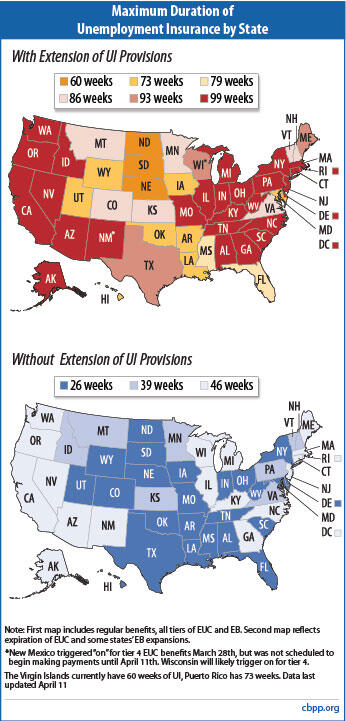- Home
- Failure To Renew Federal Benefits Change...
Failure to Renew Federal Benefits Changes the Map for State Unemployment Insurance Coverage
Policy Basics: How Many Weeks of Unemployment Compensation Are Available?
Congress’s failure to extend the measures providing extra weeks of unemployment insurance (UI) and subsidized COBRA health insurance coverage for unemployed workers – which President Obama and Congress enacted in the 2009 American Recovery and Reinvestment Act – has greatly reduced the number of weeks of UI benefits currently available in every state (see map below). Opponents’ unwarranted objections to extending those measures unless Congress offsets the costs creates speed bumps in an economy trying to recover from the worst recession since the 1930s and uncertainty for unemployed workers and their families.[1]
Maximum Duration of Unemployment Insurance Under the Recovery Act
The total number of weeks of benefits available in any particular state depends on the unemployment rate and unemployment insurance laws in the state where the person worked.
- Workers in any state can receive up to 26 weeks of benefits from the regular state-funded unemployment compensation program.
- Until the Recovery Act provisions extending UI benefits expired, (1) workers in any state who exhausted their regular UI benefits before they could find a job could receive up to 34 additional weeks of benefits through the temporary federal Emergency Unemployment Compensation (EUC) program, and (2) workers in states with especially high unemployment rates could have received 53 additional weeks of benefits under EUC (see Table 1).
- Workers who exhaust their regular UI and EUC benefits can receive additional weeks of benefits (13 weeks in some states, 20 weeks in others) through the permanent federal-state Extended Benefits (EB) program if their state’s unemployment insurance laws allow it.
| Table 1: | |
| Program and Unemployment Rate Threshold | Additional Weeks |
| Emergency Unemployment Compensation (EUC) | |
| less than 6 percent | 34 |
| at least 6 percent, but less than 8.5 percent | 47 |
| at least 8.5 percent | 53 |
| Extended Benefits (EB)* | |
| at least 6.5 percent, but less than 8 percent | 13 |
| at least 8 percent | 20 |
| * Not currently available in every state. | |
The top map on the next page shows the maximum number of weeks of benefits available in each state. Table 2 shows how many states fall into each category, and what combination of regular UI, EUC, and EB benefits produces the total for those states.
| Table 2: | |||||
| Maximum Duration | Unemployment Range | Reg. UI Available | EUC Available | EB Available | Number of States |
| 60 weeks | less than 6 percent | 26 wks | 34 wks | none | 3 |
| 73 weeks | at least 6, but less than 8.5 percent | 26 wks | 47 wks | none | 8 |
| 79 weeks | at least 8.5 percent | 26 wks | 53 wks | none | 2 |
| 86 weeks | at least 6.5, but less than 8 percent | 26 wks | 47 wks | 13 wks | 7 |
| 93 weeks | at least 8, but less than 8.5 percent | 26 wks | 47 wks | 20 wks | 3 |
| 99 weeks | at least 8.5 percent | 26 wks | 53 wks | 20 wks | 28 |
| Source: US Department of Labor Employment and Training Administration | |||||
Maximum Duration of Unemployment Insurance Without the Recovery Act
Because Congress allowed them to expire on April 5, the Recovery Act’s UI provisions were not in effect this week. Without extensions of those provisions, workers in most states receive just the 26 weeks of regular state UI benefits.
The EB triggers in Table 1 are optional triggers for the states, and many have chosen to adopt them only so long as the Recovery Act is in effect and the states receive full federal funding for EB (normally the cost of EB is split 50-50 between the states and the federal government). The states with more than 26 weeks in the lower map on the next page are those where EB is still active.[2]

Congress Should Act Quickly to Extend UI/COBRA Benefits Through the End of This Year
End Notes
[1] See Chad Stone, “Congress Should Act Quickly to Extend UI/COBRA Benefits Through the End of This Year,” Center on Budget and Policy Priorities, April 12, 2010.
[2] Some of these states have permanently adopted the optional EB triggers shown in Table 1, but EB is triggered in other states by a different measure of high unemployment.

